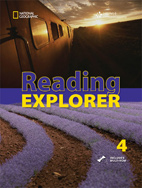Reading Explorer 4
reviewed by Neil McBeath, Oman
Menu
About the book
Reading Explorer 4 IS new
Reference

Reading Explorer 4
Paul MacIntyre
Heinle Cengage Learning
Pp. 224 ISBN 13-978-1-4240-2939-6
I once had the dispiriting experience of attending a meeting with three self-proclaimed “experts” in EFL, one of whom suddenly stated “There are no new textbooks! There are no new textbooks!” as if repetition would make such obvious nonsense true.
There are new textbooks. There are new textbooks every year, but few of them reach the standard that has been set by Reading Explorer 4.
The back cover of the book states that it is designed for High Intermediate students; that it uses 2600-3000 headwords, and that it could be used with students at C1 level on the Common European Framework of Reference.
None of that is new. We have all seen other books that match those criteria. What is new is that in Reading Explorer 4 we finally have a reading course which is actually worth reading; a reading course whose passages can be read for pleasure, and which hold the interest of even a native speaker.
Reading Explorer 4 has been created in partnership with the National Geographic, and it shows. When the blurb mentions “stunning visuals” this is not just marketing hype. Throughout the text the illustrations catch, and hold, the attention. Many of them, like the New Guinea tribesman on P. 33, work at different levels, and yet they always support the text. They never dominate it.
The text, moreover, is divided into 12 units and four review quizzes; quizzes that genuinely review material from the preceding units, supporting the ideas and taking them further. There is also a list of Target Vocabulary (Pp. 209-210) where items are cross-referenced to the units in which they appear, and a set of Video scripts (Pp. 211-221). These complement the accompanying video DVD, but that was not available for review.
The units cover themes like Words and Pictures (Pp. 9-22), Love and Attraction (Pp. 23-36) and Food and Health (Pp. 37-50). These may sound rather uninspiring, but Words and Pictures is based on a diary kept by Howard Norman when he retraced the route of Matsuo Basho’s five-month journey through seventeenth century Japan (The Narrow Road to the Deep North). The “pictures” element is an interview with the Japanese-American photographer Michael Yamashita.
Similarly, Love and Attraction offers two scientific explanations for physical attraction, followed by a description of the mating rituals of birds of paradise.
In these units, as throughout the book, the central passage is introduced by a pre-reading exercise, and a scanning, or prediction activity. The passage is followed by a multiple-choice reading comprehension, True/False questions, vocabulary based matching exercises and completion exercises.
This may sound rather mechanical, and it is open to the charge that it is rather too examination based, but again, Reading Explorer 4 offers surprises.
A vocabulary exercise from Unit 9, Reputations (Pp. 137-150), for example, asks students to complete a passage that is illustrated with the family tree of Genghis Khan’s descendents. A similar passage (P. 149) concerns Tsar Ivan IV (Ivan the Terrible). In both instances, students use lexis to complete a text and then use what they have created to match the target lexical items with their definitions. In both exercises there are distracters, and so these tasks demand advanced reading skills and critical thinking.
Reading Explorer 4 is original. It is also international in scope. Unit 7, Song and Dance (Pp. 109-122) features Bollywood movies and Argentinian tango. Unit 12, Quality of Life (pp. 187-200) concentrates on Bhutan and Sardinia. It is all a long way from “measuring practices within various cultures against a given “norm” (usually, in the past, in the English-teaching world, a white anglo-saxon one)” (Sharpling and Smith 2004;i).
Reading Explorer 4 IS new. It is excellent. It is most highly recommended.
Sharpling, Gerald and Smith, Richard. (2004) Introduction. English Language Teacher
Education and Development. 8. University of Warwick, Centre for English Language
Teacher Education and University of Birmingham, Centre for English Language
Studies. Pp. i-iv.

Please check the CLIL - Teaching Other Subject Through English course at Pilgrims website.
Please check the Methodology and Language for Secondary Teachers course at Pilgrims website.


|